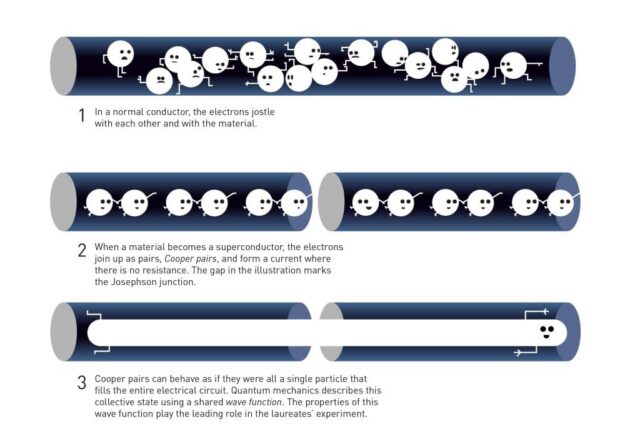The 2025 Nobel Prize in Physics awarded for quantum tunneling at the macroscopic scale

(Left to right): John Clarke, Michel H. Devour and John M. Martinis.
Credit: Niklas Elmehed/Nobel Prize Promotion
From subatomic to macro scale
Clarke, Devoret, and Martinis were the first to demonstrate that quantum effects, such as quantum tunneling and energy quantization, can operate on macroscopic scales, not just one particle at a time.
After earning his doctorate at the University of Cambridge, Clarke arrived at the University of California, Berkeley as a postdoctoral fellow, before joining the faculty in 1969. By the mid-1980s, Devoret and Martinis had joined Clarke’s laboratory as a postdoctoral fellow and graduate student, respectively. The trio decided to look for evidence of macroscopic quantum tunneling using a specialized circuit called a Josephson junction, a macroscopic device that takes advantage of tunneling now widely used in quantum computing, quantum sensing, and cryptography.
A Josephson junction, named after the British physicist Brian Josephson, winner of the Nobel Prize in Physics in 1973, is essentially composed of two semiconductor elements separated by an insulating barrier. Despite this small space between two conductors, electrons can still pass through the insulation and create a current. This happens at low enough temperatures, when the junction becomes superconducting as the electrons form what are called “Cooper pairs.”
The team built an electrical circuit-based oscillator on a microchip measuring about a centimeter, essentially a quantum version of the classical pendulum. Their biggest challenge was figuring out how to reduce the noise from their experimental device. For their experiments, they first introduced a small current into the junction and measured the voltage, initially zero. Then they increased the current and measured how long it took for the system to come out of its closed state to produce a voltage.

Credit: Johan Jarnestad/Royal Swedish Academy of Sciences
They took numerous measurements and found that the average current increased as the device temperature decreased, as expected. But at some point, the temperature became so low that the device became superconducting and the average current became independent of the device’s temperature – a telltale signature of macroscopic quantum tunneling.




